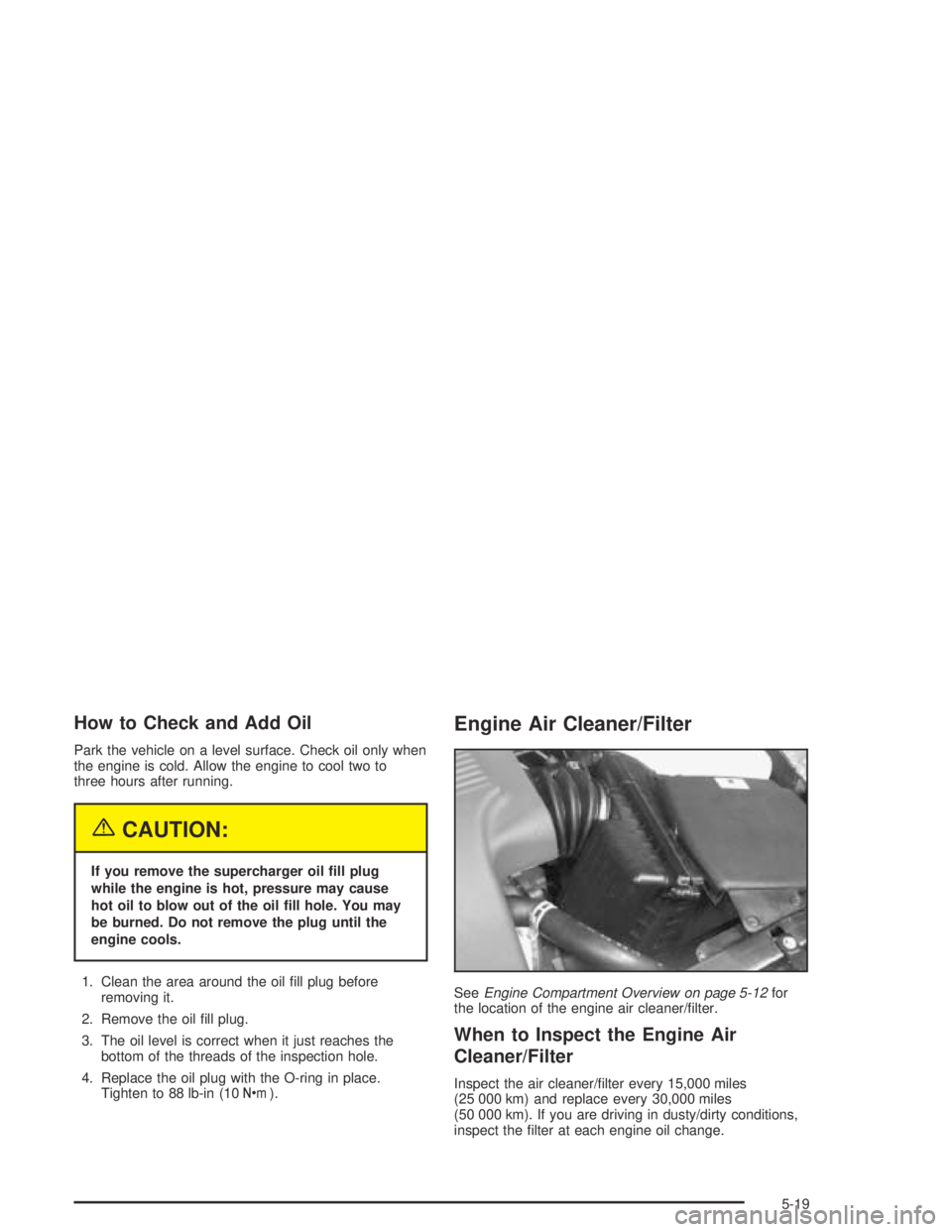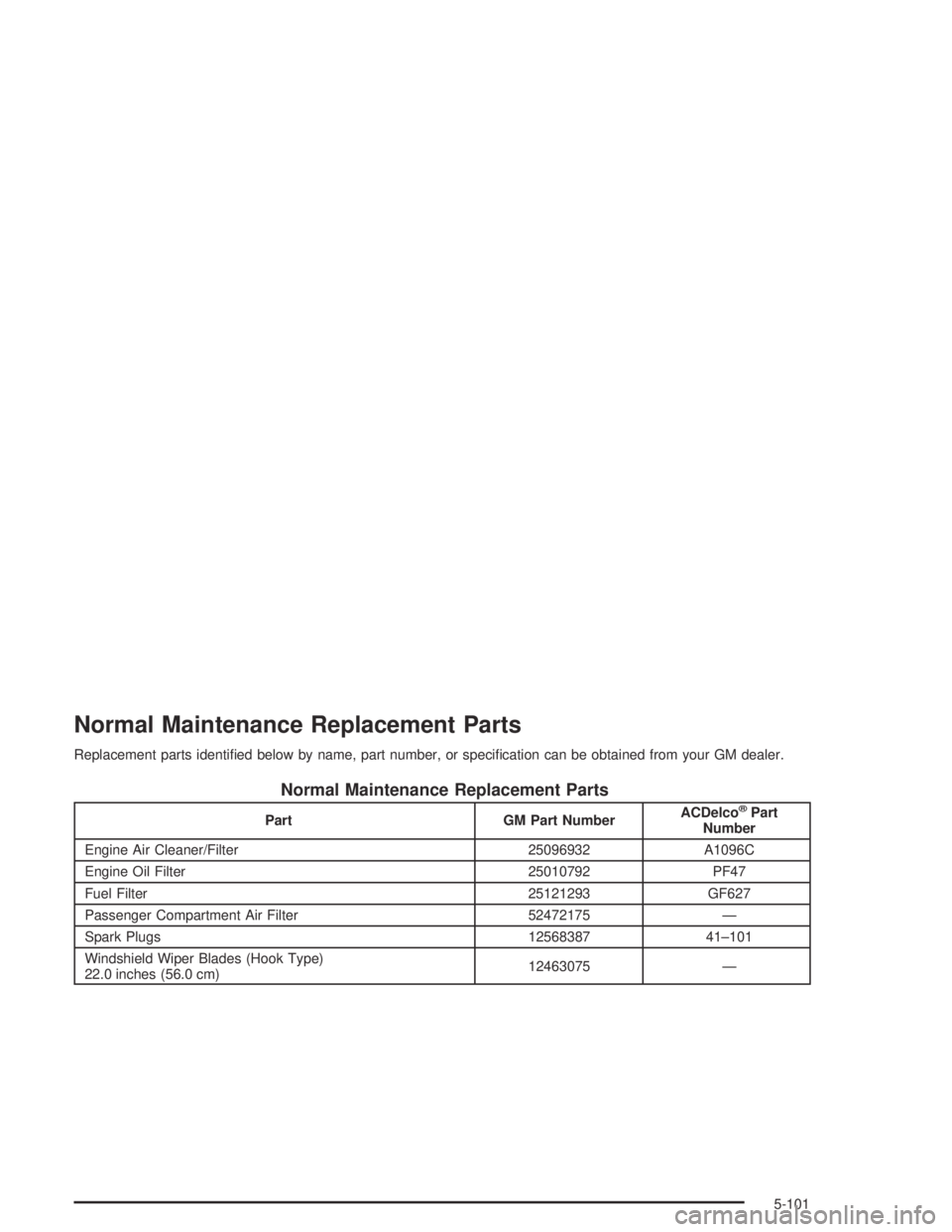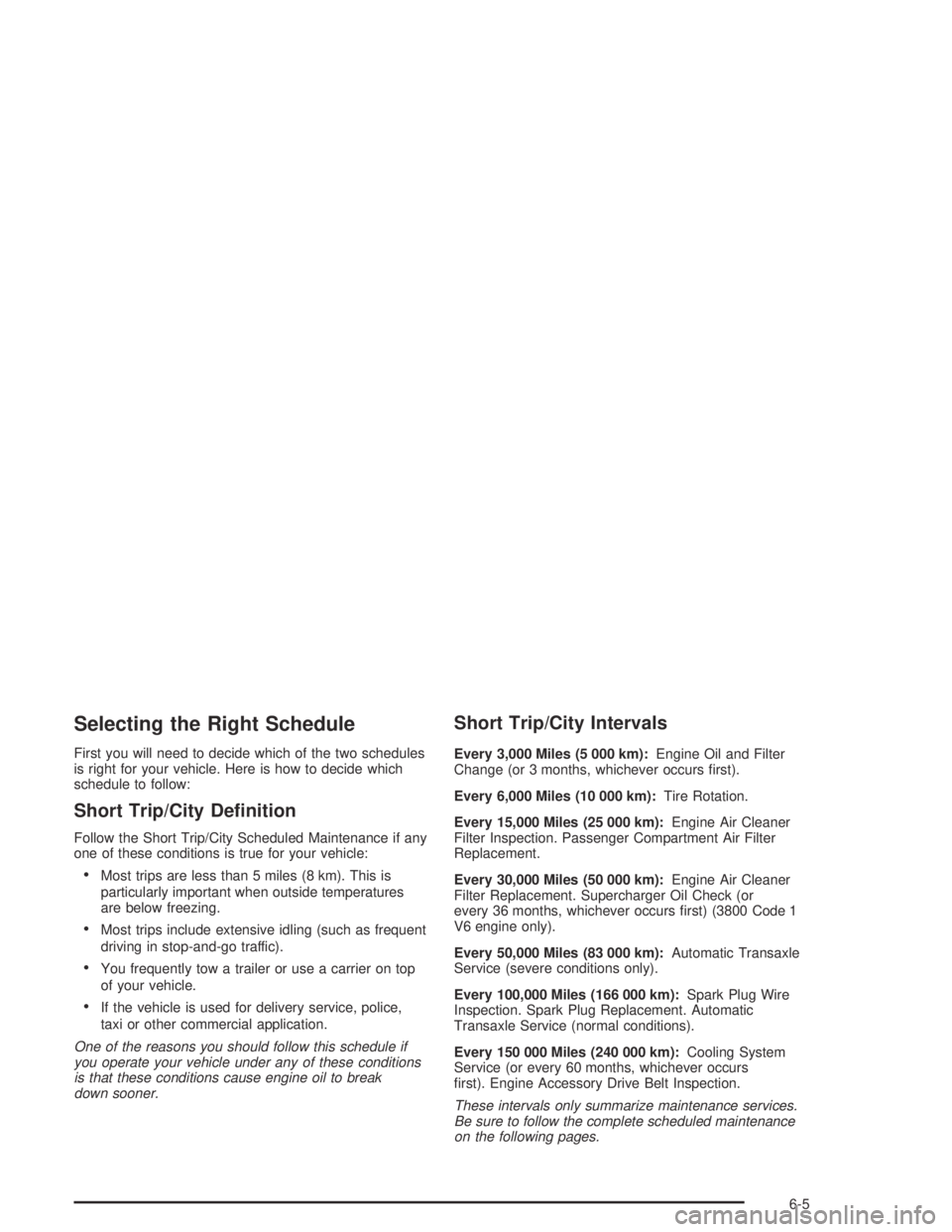2005 BUICK PARK AVENUE oil filter
[x] Cancel search: oil filterPage 233 of 388

Service............................................................5-3
Doing Your Own Service Work.........................5-3
Adding Equipment to the Outside of
Your Vehicle..............................................5-4
Fuel................................................................5-4
Gasoline Octane............................................5-4
Gasoline Speci�cations....................................5-5
California Fuel...............................................5-5
Additives.......................................................5-5
Fuels in Foreign Countries...............................5-6
Filling Your Tank............................................5-6
Filling a Portable Fuel Container.......................5-9
Checking Things Under the Hood....................5-10
Hood Release..............................................5-10
Engine Compartment Overview.......................5-12
Engine Oil...................................................5-13
Engine Oil Life System..................................5-17
Supercharger Oil..........................................5-18
Engine Air Cleaner/Filter................................5-19
Automatic Transaxle Fluid..............................5-22
Engine Coolant.............................................5-24
Radiator Pressure Cap..................................5-26
Engine Overheating.......................................5-26
Cooling System............................................5-28
Power Steering Fluid.....................................5-34Windshield Washer Fluid................................5-35
Brakes........................................................5-37
Battery........................................................5-40
Jump Starting...............................................5-41
Headlamp Aiming...........................................5-45
Bulb Replacement..........................................5-47
Halogen Bulbs..............................................5-47
Headlamps..................................................5-47
Front Turn Signal Lamps...............................5-50
Rear Turn Signal, Stoplamps and
Back-Up Lamps........................................5-50
Rear Quarter Panel Turn Signal
and Stoplamps..........................................5-54
Replacement Bulbs.......................................5-56
Windshield Wiper Blade Replacement..............5-57
Tires..............................................................5-58
Tire Sidewall Labelling...................................5-59
Tire Terminology and De�nitions.....................5-61
In�ation - Tire Pressure.................................5-64
Check Tire Pressure System..........................5-65
Tire Inspection and Rotation...........................5-67
When It Is Time for New Tires.......................5-68
Buying New Tires.........................................5-68
Uniform Tire Quality Grading..........................5-69
Section 5 Service and Appearance Care
5-1
Page 245 of 388

A. Battery. SeeBattery on page 5-40.
B. Underhood Fuse Block. SeeUnderhood Fuse Block
on page 5-95.
C. Radiator Pressure Cap. SeeRadiator Pressure Cap
on page 5-26.
D. Engine Oil Dipstick. See “Checking Engine Oil”
underEngine Oil on page 5-13.
E. Engine Oil Fill Cap. See “When to Add Engine Oil”
underEngine Oil on page 5-13.
F. Engine Coolant Air Bleed Valve. See “How to Add
Coolant to the Radiator” underCooling System
on page 5-28.
G. Automatic Transaxle Fluid Dipstick. See “Checking
the Fluid Level” underAutomatic Transaxle Fluid
on page 5-22.
H. Brake Master Cylinder Reservoir. See “Brake Fluid”
underBrakes on page 5-37.
I. Windshield Washer Fluid Reservoir. See “Adding
Washer Fluid” underWindshield Washer Fluid
on page 5-35.
J. Engine Coolant Recovery Tank. SeeCooling System
on page 5-28.
K. Engine Air Cleaner/Filter. SeeEngine Air
Cleaner/Filter on page 5-19.Engine Oil
If the DIC message, ENGINE OIL LOW — CHECK
LEVEL appears on the instrument cluster, it means you
need to check your engine oil level right away. For
more information, seeDriver Information Center (DIC)
on page 3-46.
You should check your engine oil level regularly; this is
an added reminder.
Checking Engine Oil
It is a good idea to check your engine oil every time you
get fuel. In order to get an accurate reading, the oil
must be warm and the vehicle must be on level ground.
The engine oil dipstick handle is a yellow loop. See
Engine Compartment Overview on page 5-12for
the location of the engine oil dipstick.
5-13
Page 251 of 388

How to Check and Add Oil
Park the vehicle on a level surface. Check oil only when
the engine is cold. Allow the engine to cool two to
three hours after running.
{CAUTION:
If you remove the supercharger oil �ll plug
while the engine is hot, pressure may cause
hot oil to blow out of the oil �ll hole. You may
be burned. Do not remove the plug until the
engine cools.
1. Clean the area around the oil �ll plug before
removing it.
2. Remove the oil �ll plug.
3. The oil level is correct when it just reaches the
bottom of the threads of the inspection hole.
4. Replace the oil plug with the O-ring in place.
Tighten to 88 lb-in (10Y).
Engine Air Cleaner/Filter
SeeEngine Compartment Overview on page 5-12for
the location of the engine air cleaner/�lter.
When to Inspect the Engine Air
Cleaner/Filter
Inspect the air cleaner/�lter every 15,000 miles
(25 000 km) and replace every 30,000 miles
(50 000 km). If you are driving in dusty/dirty conditions,
inspect the �lter at each engine oil change.
5-19
Page 332 of 388

Capacities and Speci�cations
The following approximate capacities are given in English and metric conversions. Please refer toPart D:
Recommended Fluids and Lubricants on page 6-25for more information.
ApplicationCapacities
English Metric
Air Conditioning Refrigerant R134a 2.2 lbs 1.0 kg
Automatic Transaxle 7.4 quarts 7.0 L
Engine Cooling System 13.0 quarts 12.3 L
Engine Oil with Filter 4.5 quarts 4.3 L
Fuel Tank 18.5 gallons 70.0 L
Wheel Nut Torque 100 ft lb 140Y
All capacities are approximate. When adding, be sure to �ll to the appropriate level, as recommended in
this manual.
Engine VIN Code Transaxle Spark Plug Gap
3800 3.8L V6 K Automatic 0.060 inch (0.152 cm)
3800 3.8L V6
Supercharged1 Automatic 0.060 inch (0.152 cm)
5-100
Page 333 of 388

Normal Maintenance Replacement Parts
Replacement parts identi�ed below by name, part number, or speci�cation can be obtained from your GM dealer.
Normal Maintenance Replacement Parts
Part GM Part NumberACDelco®Part
Number
Engine Air Cleaner/Filter 25096932 A1096C
Engine Oil Filter 25010792 PF47
Fuel Filter 25121293 GF627
Passenger Compartment Air Filter 52472175 —
Spark Plugs 12568387 41–101
Windshield Wiper Blades (Hook Type)
22.0 inches (56.0 cm)12463075 —
5-101
Page 339 of 388

Selecting the Right Schedule
First you will need to decide which of the two schedules
is right for your vehicle. Here is how to decide which
schedule to follow:
Short Trip/City De�nition
Follow the Short Trip/City Scheduled Maintenance if any
one of these conditions is true for your vehicle:
Most trips are less than 5 miles (8 km). This is
particularly important when outside temperatures
are below freezing.
Most trips include extensive idling (such as frequent
driving in stop-and-go traffic).
You frequently tow a trailer or use a carrier on top
of your vehicle.
If the vehicle is used for delivery service, police,
taxi or other commercial application.
One of the reasons you should follow this schedule if
you operate your vehicle under any of these conditions
is that these conditions cause engine oil to break
down sooner.
Short Trip/City Intervals
Every 3,000 Miles (5 000 km):Engine Oil and Filter
Change (or 3 months, whichever occurs �rst).
Every 6,000 Miles (10 000 km):Tire Rotation.
Every 15,000 Miles (25 000 km):Engine Air Cleaner
Filter Inspection. Passenger Compartment Air Filter
Replacement.
Every 30,000 Miles (50 000 km):Engine Air Cleaner
Filter Replacement. Supercharger Oil Check (or
every 36 months, whichever occurs �rst) (3800 Code 1
V6 engine only).
Every 50,000 Miles (83 000 km):Automatic Transaxle
Service (severe conditions only).
Every 100,000 Miles (166 000 km):Spark Plug Wire
Inspection. Spark Plug Replacement. Automatic
Transaxle Service (normal conditions).
Every 150 000 Miles (240 000 km):Cooling System
Service (or every 60 months, whichever occurs
�rst). Engine Accessory Drive Belt Inspection.
These intervals only summarize maintenance services.
Be sure to follow the complete scheduled maintenance
on the following pages.
6-5
Page 340 of 388

Long Trip/Highway De�nition
Follow this scheduled maintenanceonlyif none of the
conditions from the Short Trip/City Scheduled
Maintenance are true. Do not use this schedule if the
vehicle is used for trailer towing, driven in a dusty area
or used off paved roads. Use the Short Trip/City
schedule for these conditions
Driving a vehicle with a fully warmed engine under
highway conditions will cause engine oil to break
down slower.
Long Trip/Highway Intervals
Every 7,500 Miles (12 500 km):Engine Oil and Filter
Change (or every 12 months, whichever occurs
�rst). Tire Rotation.
Every 15,000 Miles (25 000 km):Engine Air
Cleaner Filter Inspection. Passenger Compartment Air
Filter Replacement.
Every 30,000 Miles (50 000 km):Supercharger Oil
Check (or every 36 months, whichever occurs �rst)
(3800 Code 1 V6 engine only). Engine Air Cleaner
Filter Replacement.
Every 50,000 Miles (83 000 km):Automatic Transaxle
Service (severe conditions only).Every 100,000 Miles (166 000 km):Spark Plug Wire
Inspection. Spark Plug Replacement. Automatic
Transaxle Service (normal conditions).
Every 150,000 Miles (240 000 km):Cooling System
Service (or every 60 months, whichever occurs
�rst). Engine Accessory Drive Belt Inspection.
These intervals only summarize maintenance services.
Be sure to follow the complete scheduled maintenance
on the following pages.
Short Trip/City
Scheduled Maintenance
The services shown in this schedule up to 100,000 miles
(166 000 km) should be repeated after 100,000 miles
(166 000 km) at the same intervals for the life of
this vehicle. The services shown at 150,000 miles
(240 000 km) should be repeated at the same
interval after 150,000 miles (240 000 km) for the life of
this vehicle.
SeePart B: Owner Checks and Services on page 6-19
andPart C: Periodic Maintenance Inspections on
page 6-23.
6-6
Page 342 of 388

9,000 Miles (15 000 km)
❑Change engine oil and �lter (or every 3 months,
whichever occurs �rst).An Emission Control Service.
(See footnote *.)
12,000 Miles (20 000 km)
❑Change engine oil and �lter (or every 3 months,
whichever occurs �rst).An Emission Control Service.
(See footnote *.)
❑Rotate tires. SeeTire Inspection and Rotation on
page 5-67for proper rotation pattern and additional
information.(See footnote @.) (See footnote +.)
15,000 Miles (25 000 km)
❑Change engine oil and �lter (or every 3 months,
whichever occurs �rst).An Emission Control Service.
(See footnote *.)
❑Inspect engine air cleaner �lter. If necessary, replace
the �lter. If vehicle is driven in dusty/dirty conditions,
inspect �lter at every engine oil change. See
Engine Air Cleaner/Filter on page 5-19for more
information.An Emission Control Service. (See
footnote †.)
❑Replace passenger compartment air �lter.
18,000 Miles (30 000 km)
❑Change engine oil and �lter (or every 3 months,
whichever occurs �rst).An Emission Control Service.
(See footnote *.)
❑Rotate tires. SeeTire Inspection and Rotation on
page 5-67for proper rotation pattern and additional
information.(See footnote @.) (See footnote +.)
21,000 Miles (35 000 km)
❑Change engine oil and �lter (or every 3 months,
whichever occurs �rst).An Emission Control Service.
(See footnote *.)
24,000 Miles (40 000 km)
❑Change engine oil and �lter (or every 3 months,
whichever occurs �rst).An Emission Control Service.
(See footnote *.)
❑Rotate tires. SeeTire Inspection and Rotation on
page 5-67for proper rotation pattern and additional
information.(See footnote @.) (See footnote +.)
27,000 Miles (45 000 km)
❑Change engine oil and �lter (or every 3 months,
whichever occurs �rst).An Emission Control Service.
(See footnote *.)
6-8